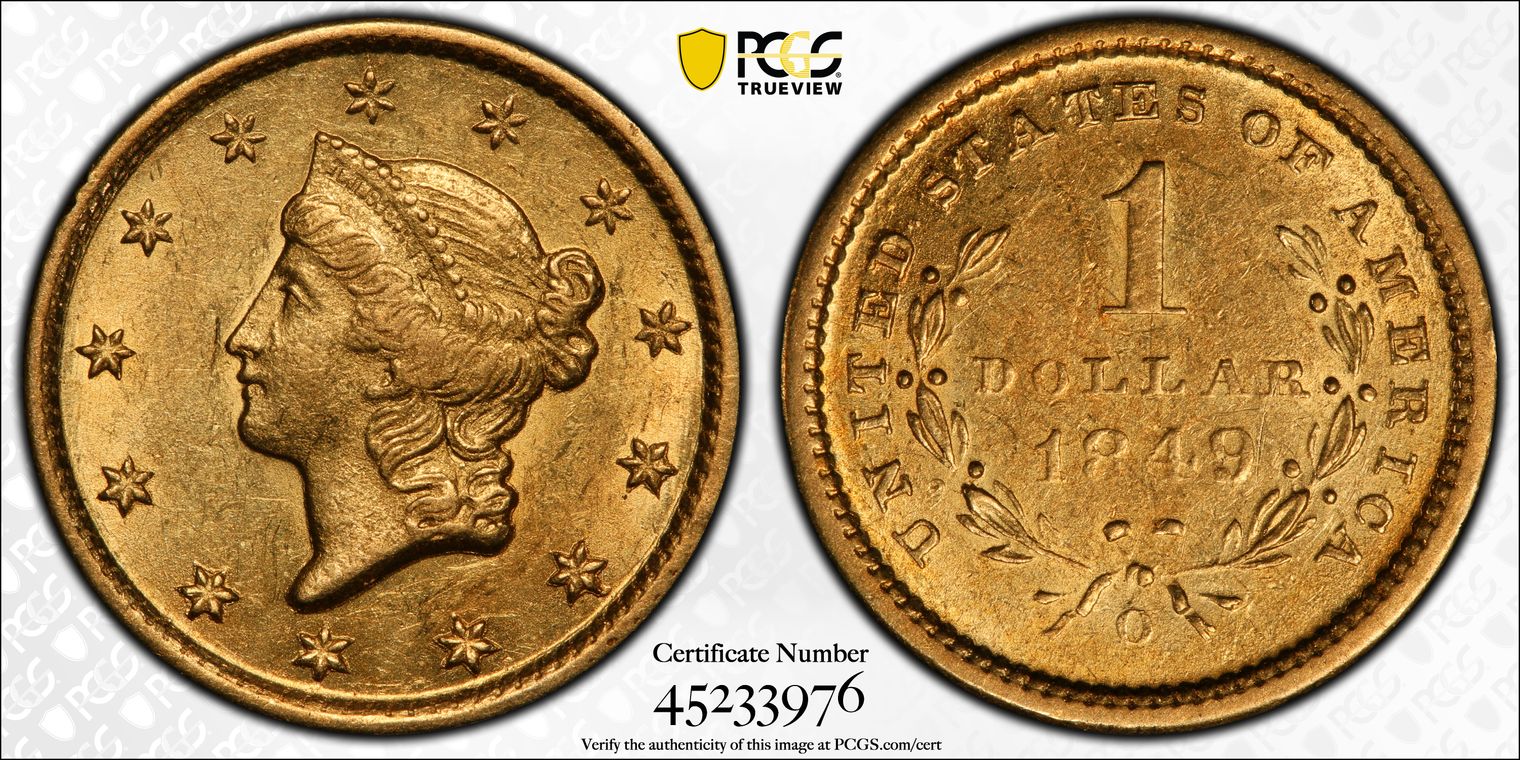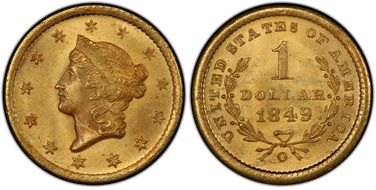1849-O G$1 AU58 认证号45233976, PCGS号7508
专家评论
David Akers (1975/88)
Although this date is more common than the 1849-D from the standpoint of total number of pieces available, the data clearly indicates that it is more difficult to obtain in grades of Unc. and AU. Nearly half the specimens offered in our 192 cataloue sample graded VF and below and, in fact, the 1849-O had the fifth lowest average grade of the 82 different gold dollars.Doug Winter
The 1849-O is popular due to its status as the first gold dollar from the New Orleans mint. It is far more available than once believed and can be found with little difficulty in all grades up to and including MS62.Strike: Around three-quarters of the known examples are sharper on the obverse than on the reverse. Depending on the variety (see below) there is often some weakness on the date and mintmark, with the weakest areas being the bottom of the LL in DOLLAR, the 8 in the date and the top of the mintmark. The denticles are usually complete on the obverse and reverse.
Surfaces: Most 1849-O gold dollars are seen with numerous scuffmarks and abraisions in the fields. The areas that are most prone to marks are the left obverse and central reverse.
Luster: The luster is usually frosty but more granular in texture than on later issues such as the 1851-O and 1852-O. Some 1849-O gold dollars are seen with semi-prooflike luster and a few are fairly reflective. The luster on the obverse is generally better than that on the reverse.
Coloration: The natural coloaration is greenish-gold and, less often, pieces are seen with a medium orange-gold hue. A number are found with either copper spots or small areas of blackish discoloration.
Eye appeal: The level of eye appeal for this date is not as good as it is for the 1851-O or the 1852-O, but it is better than that seen on most 1850-O gold dollars. However, it is not especially hard to find an 1849-O that has a good strike, nice color and decent surfaces.
Die characteristics: On some examples the stars at 12:00 and 1:00 are thinner than those at the bottom due to die lapping. Some are seen with die polish in the obverse fields, especially in front of Liberty's face and, less often, behind the head. Many are found with obverse craacks which are most bold at 4:00, the tip of the bust to the rim at 7:00 and at the star at 11:00 towards the forehead.
Major varieties: All seen have an open wreath and a small mintmark. The Liberty Head is large with the point of the coronet close to the star at 12:00. At least two varieties are known:
Variety One: The obverse has the stars lighter at the top than the bottom and is often cracked. The stars show doubling. It is often weak at the central reverse. The mintmark is straight. This appears to be the more common of the two varieties.
Variety Two: The stars are heavier than on the other variety and more even (in terms of size) on the top and bottom. The reverse center is better struck than on Variety One. The mintmark tilts to the left.
PCGS #
7508
设计师
James Barton Longacre
边缘
Reeded
直径
12.70 毫米
重量
1.70 克
铸币数量
215000
金属成分
90% Gold, 10% Copper
更高评级数量
209
评级较低的钱币数量
274
地区
The United States of America
价格指南
PCGS 数量报告
拍卖 - PCGS 评级的
拍卖 - NGC 评级的
稀有性和存量估计 了解更多
| 所有评级 | 875 |
| 60或以上 | 250 |
| 65或以上 | 5 |
| 所有评级 | R-5.2 |
| 60或以上 | R-6.6 |
| 65或以上 | R-9.7 |
| 所有评级 | 19 / 26 |
| 60或以上 | 16 / 26 |
| 65或以上 | 7 / 26 |
| 所有评级 | 59 / 81 |
| 60或以上 | 49 / 81 TIE |
| 65或以上 | 11 / 81 TIE |























